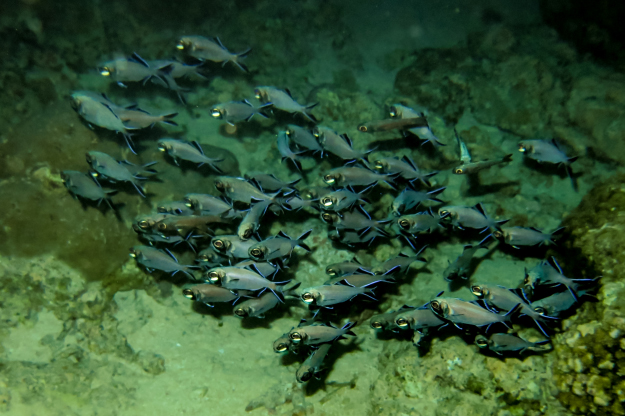Twofin Flashlightfish, Anomalops katoptron (Bleeker 1856)
Other Names: Splitfin Flashlightfish, Two-fin Flashlightfish

A school of Twofin Flashlightfish, Anomalops katoptron, in the Banda Islands, Indonesia. Source: Fig 1b, in Hellinger et al. 2017 PLoS ONE 12(2): e0170489. doi:10.1371/journal.pone.0170489. License: CC BY Attribution
Summary:
A flashlight fish with a bean-shaped light organ under the eye that produces a bluish light, presumably to locate planktonic prey, communicate with others of the same species and avoid predators. The light organs are densely settled with luminous symbiotic bacteria that grow in tubular structures and produce a constant bluish light that is enhanced by a reflector on the back of the light organ (Hellinger et al. 2017).
The light, produced by symbiotic bacteria living within the organ, is "turned off" (cannot be seen) when the fish rotates the organ inwards.
The Twofin Flashlightfish shelters in caves and crevices during the day, emerging at night to feed on zooplankton.
Video of Twofin Flashlightfish in the dark in a small cave in the Solomon Islands.
Twofin Flashlightfish at the Hong Kong Ocean Park.
The light, produced by symbiotic bacteria living within the organ, is "turned off" (cannot be seen) when the fish rotates the organ inwards.
The Twofin Flashlightfish shelters in caves and crevices during the day, emerging at night to feed on zooplankton.
Video of Twofin Flashlightfish in the dark in a small cave in the Solomon Islands.
Twofin Flashlightfish at the Hong Kong Ocean Park.
Cite this page as:
Bray, D.J. 2017, Anomalops katoptron in Fishes of Australia, accessed 10 Jul 2025, https://fishesofaustralia.net.au/Home/species/3734
Twofin Flashlightfish, Anomalops katoptron (Bleeker 1856)
More Info
|
Distribution |
Recorded in Australia from the northern Great Barrier Reef and the Coral Sea off Queensland. The species occurs elsewhere in the tropical, Indo-west Pacific. The species is nocturnal and occurs in large schools in near surface waters at night. |
|
Species Citation |
Heterophthalmus katoptron Bleeker, 1856, Acta Soc. Scient. Indo-Neerland 1: 43. Type locality: Manado, Makassar, Indonesia. |
|
Author |
Bray, D.J. 2017 |
Twofin Flashlightfish, Anomalops katoptron (Bleeker 1856)
References
Allen, G.R. & Erdmann, M.V. 2012. Reef fishes of the East Indies. Perth : Tropical Reef Research 3 vols, 1260 pp.
Bleeker, P. 1856. Beschrijvengen van nieuwe of weinig bekende vischsoorten van Menado en Makassar grootendeels verzameld op eene reis naar den Molukschen Archipel in het gevolg van den Gouverneur-Generaal Duymaer van Twist. Acta Societatis Scientiarum Indo-Neerlandicae 1: 1-80.
Hellinger J, Jägers P, Donner M, Sutt F, Mark MD, Senen B, et al. (2017) The Flashlight Fish uses bioluminescent light to detect prey in the dark. PLoS ONE 12(2): e0170489. doi:10.1371/journal.pone.0170489 Open access
Hemdal, J.F. 1992. Captive husbandry of the flashlight fish, Anomolops katoptron. Journal of Aquariculture and Aquatic Sciences 6(2): 55-57.
Johnson, G.D. & Rosenblatt, R.H. 1988. Mechanisms of light organ occlusion in flashlightfishes, family Anomalopidae (Teleostei: Beryciformes), and the evolution of the group. Journal of the Linnean Society of London, Zoology 94: 65-96.
McCosker, J.E. 1977. Flashlight fishes. Scientific American 263(3): 106-114 12 figs
McCosker, J.E. & Rosenblatt, R.H. 1987. Notes on the biology, taxonomy, and distribution of the flashlight fishes (Beryciformes: Anomalopidae). Japanese Journal of Ichthyology 34(2): 157-164.
Paxton, J.R. & Johnson, G.D. 1999. Family Anomalopidae. pp. 2212-2213 in Carpenter, K.E. & Niem, T.H. (eds). The Living Marine Resources of the Western Central Pacific. FAO Species Identification Guide for Fisheries Purposes. Rome : FAO Vol. 4 2069-2790 pp.
Randall, J.E. 2005. Reef and shore fishes of the South Pacific. New Caledonia to Tahiti and the Pitcairn Islands. Honolulu : University of Hawaii Press 707 pp.
Randall, J.E., Allen, G.R. & Steene, R. 1997. Fishes of the Great Barrier Reef and Coral Sea. Bathurst : Crawford House Press 557 pp. figs.
Rosenblatt, R.H. & Montgomery, W.L. 1976. Kryptophaneron harveyi, a new anomalopid fish from the eastern tropical Pacific and the evolution of the Anomalopidae. Copeia 1976(3): 510-515 figs 1-2







